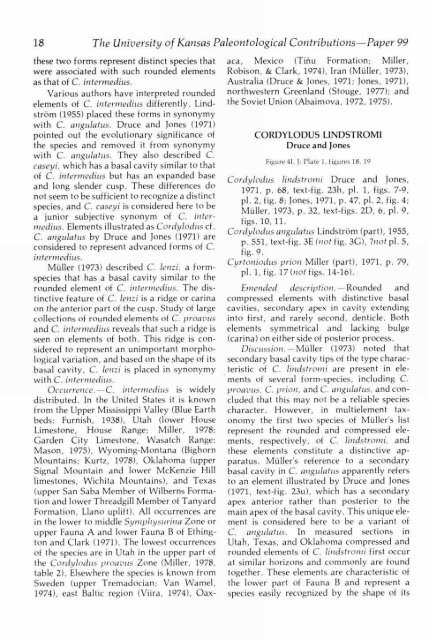View - KU ScholarWorks - University of Kansas
View - KU ScholarWorks - University of Kansas
View - KU ScholarWorks - University of Kansas
Create successful ePaper yourself
Turn your PDF publications into a flip-book with our unique Google optimized e-Paper software.
18 The <strong>University</strong> <strong>of</strong> <strong>Kansas</strong> Paleontological Contributions-Paper 99<br />
these two forms represent distinct species that<br />
were associated with such rounded elements<br />
as that <strong>of</strong> C. interrnedius.<br />
Various authors have interpreted rounded<br />
elements <strong>of</strong> C. intertnedius differently. Lindstrom<br />
(1955) placed these forms in synonymy<br />
with C. angulatus. Druce and Jones (1971)<br />
pointed out the evolutionary significance <strong>of</strong><br />
the species and removed it from synonymy<br />
with C. augulatus. They also described C.<br />
caseyi, which has a basal cavity similar to that<br />
<strong>of</strong> C. intermeditis but has an expanded base<br />
and long slender cusp. These differences do<br />
not seem to be sufficient to recognize a distinct<br />
species, and C. caseyi is considered here to be<br />
a junior subjective synonym <strong>of</strong> C. intertnedius.<br />
Elements illustrated as Cordylodus cf.<br />
C. angulatus by Druce and Jones (1971) are<br />
considered to represent advanced forms <strong>of</strong> C.<br />
intertnedius.<br />
Iler (1973) described C. lenzi, a formspecies<br />
that has a basal cavity similar to the<br />
rounded element <strong>of</strong> C. intermedius. The distinctive<br />
feature <strong>of</strong> C. lenzi is a ridge or caria<br />
on the anterior part <strong>of</strong> the cusp. Study <strong>of</strong> large<br />
collections <strong>of</strong> rounded elements <strong>of</strong> C. proavus<br />
and C. intertnedius reveals that such a ridge is<br />
seen on elements <strong>of</strong> both. This ridge is considered<br />
to represent an unimportant morphological<br />
variation, and based on the shape <strong>of</strong> its<br />
basal cavity, C. lenzi is placed in synonymy<br />
with C. intermedius.<br />
Occurrence. -C. intermedius is widely<br />
distributed. In the United States it is known<br />
from the Upper Mississippi Valley (Blue Earth<br />
beds; Furnish, 1938), Utah (lower House<br />
Limestone, House Range; Miller, 1978;<br />
Garden City Limestone, Wasatch Range;<br />
Mason, 1975), Wyoming-Montana (Bighorn<br />
Mountains; Kurtz, 1978), Oklahoma (upper<br />
Signal Mountain and lower McKenzie Hill<br />
limestones, Wichita Mountains), and Texas<br />
(upper San Saba Member <strong>of</strong> Wilberns Formation<br />
and lower Threadgill Member <strong>of</strong> lanyard<br />
Formation, Llano uplift). All occurrences are<br />
in the lower to middle Symphystirina Zone or<br />
upper Fauna A and lower Fauna B <strong>of</strong> Ethington<br />
and Clark (1971). The lowest occurrences<br />
<strong>of</strong> the species are in Utah in the upper part <strong>of</strong><br />
the Cordylodus proavus Zone (Miller, 1978,<br />
table 2). Elsewhere the species is known from<br />
Sweden (upper Tremadocian; Van Warne',<br />
1974), east Baltic region (Viira, 1974), Oaxaca,<br />
Mexico (Tifiu Formation; Miller,<br />
Robison, & Clark, 1974), Iran (Muller, 1973),<br />
Australia (Druce & Jones, 1971; Jones, 1971),<br />
northwestern Greenland (Stouge, 1977); and<br />
the Soviet Union (Abaimova, 1972, 1975).<br />
CORDYLODUS LINDSTROMI<br />
Druce and Jones<br />
Figure 41, J; Plate 1, figures 18, 19<br />
Cordylodus lindstrotni Druce and Jones,<br />
1971, p. 68, text-fig. 23h, pl. 1, figs. 7-9,<br />
pl. 2, fig. 8; Jones, 1971, p. 47, pl. 2, fig. 4;<br />
Müller, 1973, p. 32, text-figs. 2D, 6, pl. 9,<br />
figs. 10, 11.<br />
Cordylodus angulatus Lindstrom (part), 1955,<br />
p. 551, text-fig. 3E (not fig. 3G), ?not pl. 5,<br />
fig. 9.<br />
Cyrtoniodus prion Miller (part), 1971, p. 79,<br />
pl. 1, fig. 17 (not figs. 14-16).<br />
Emended description. -Rounded and<br />
compressed elements with distinctive basal<br />
cavities, secondary apex in cavity extending<br />
into first, and rarely second, denticle. Both<br />
elements symmetrical and lacking bulge<br />
(caria) on either side <strong>of</strong> posterior process.<br />
Discussion. -Müller (1973) noted that<br />
secondary basal cavity tips <strong>of</strong> the type characteristic<br />
<strong>of</strong> C. lindstrotni are present in elements<br />
<strong>of</strong> several form-species, including C.<br />
proavus, C. prion, and C. angulatus, and concluded<br />
that this may not be a reliable species<br />
character. However, in multielement taxonomy<br />
the first two species <strong>of</strong> Milner's list<br />
represent the rounded and compressed elements,<br />
respectively, <strong>of</strong> C. lindstromi, and<br />
these elements constitute a distinctive apparatus.<br />
MUller's reference to a secondary<br />
basal cavity in C. angulatus apparently refers<br />
to an element illustrated by Druce and Jones<br />
(1971, text-fig. 23u), which has a secondary<br />
apex anterior rather than posterior to the<br />
main apex <strong>of</strong> the basal cavity. This unique element<br />
is considered here to be a variant <strong>of</strong><br />
C. angulatus. In measured sections in<br />
Utah, Texas, and Oklahoma compressed and<br />
rounded elements <strong>of</strong> C. lindstromi first occur<br />
at similar horizons and commonly are found<br />
together. These elements are characteristic <strong>of</strong><br />
the lower part <strong>of</strong> Fauna B and represent a<br />
species easily recognized by the shape <strong>of</strong> its
















